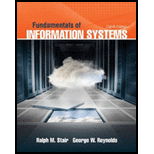
Concept explainers
Different participants involved in System Development Process.
Explanation of Solution
A system development process goes through many stages with the participation of some members. Different participants that are involved in the development of System process and their role is discussed below.
Project Manager: Project manager plays an important role in the system development process. The project manager ensure that all the objectives are met during the development process. He is also responsible with coordinating all people and resources needed to complete the project successfully. The main tasks of project manager include project scope, ensuring project quality, training personnel, facilitating communications, risk management and acquiring necessary equipment.
System Analyst: System analyst hold expertise in analyzing and designing business systems. System analysts continuously interact with stakeholders, users, management, vendors and suppliers to architect the blueprint for the proposed system. Their main role is to analyze the requirements and design the system to meet those requirements.
Programmer: The main role of programmer is to develop programs for the system according to the requirements of their clients or users. They take
Users: Users are the personnel for which system is developed or people who will continuously interact with the system. They play an important role in this process as they interact with the system and use the system.
Stakeholders: Stakeholders make investments for the development of the system and make benefits from the system after its development.
Technical specialists: Technical specialists might include
Want to see more full solutions like this?
Chapter 8 Solutions
Fundamentals of Information Systems
- The mail merge process has ____ steps. Question 19Select one: a. five b. six c. seven d. eightarrow_forwardIf you created a main document based on an existing document entitled "Confirmation Letter," what default filename would Word give the main document? Question 14Select one: a. Confirmation Letter-1 b. Confirmation Letter-merge c. Document1 d. MergedDocument1arrow_forwardClick the ____ option button in the Mail Merge task pane to use an Outlook contact list as a data source for a merge. Question 11Select one: a. Use Outlook contacts list b. Select from Outlook contacts c. Select Contacts d. Mail Merge Recipientsarrow_forward
- A(n) ____ cannot be selected as the document type in the Mail Merge task pane. Question 9Select one: a. Letter b. Directory c. Fax d. E-mail messagearrow_forwardConsider a Superstore Database which consists of 3 tables, Orders, Returns, and Managers. The CSV files have been provided along with this DOC file in the Midterm 2 Link in the Moodle. Answer the questions as below: Use the created table as in the provided SQL query file, solve the problems as mentioned below. You will have to import the respective CSV files of the above created tables as without them, it is impossible to solve the questions below. If you are not able to upload the files successfully, do not leave the query questions. Just write the query to the best of your knowledge. Do not copy. To be graded for the screenshot answer, you must upload the CSV properly and paste the resulting screenshot of the queries as asked. Write Query to Find out which Product Sub-Category has a sum of Shipping Cost to sum of Sales ratio > 0.03.arrow_forwardI need to render an image of a car continuously for a smooth visual experience in C# WinForms. It gets the location array (that has all the x,y of the tiles it should visit) from another function - assume it is already written.arrow_forward
- write c program with features: Register a Bunny: Store the bunny's name, poem, and initialize the egg count to 0. Modify an Entry: Change the bunny's poem or update the egg count. Delete a Bunny: Remove a registered bunny from the list. List All Bunnies: Display all registered bunnies and their details. Save & Load Data: Store bunny data in a file to persist between runs. Use a struct to represent a bunny contestant. Store data in a binary file (bunnies.dat) for persistence. Use file I/O functions (fopen, fwrite, fread, etc.) to manage data. Implement a menu-driven interface for user interaction.arrow_forwardHelp, how do I write the pseudocode for the findMean function and flowchart for this?arrow_forwardNeed help drawing a flowchart for the findMax function herearrow_forward
- Need help writing the pseudocode for the findMin function with attachedarrow_forwardCreate a static function in C# where poachers appear and attempt to hunt animals. It gets the location of the closest animal to itself. Take account of that the animal also move too, so it should update the closest location (x, y) everytime it moves to a new location. Use winforms to show the movements of poachers.arrow_forwardCreate a static function in C# where poachers appear and attempt to hunt animals. It gets the location of the closest animal to itself. Take account of that the animal also moves too, so it should update the closest location (x, y) everytime it moves to a new location. Use winforms to show to movementsarrow_forward
 Enhanced Discovering Computers 2017 (Shelly Cashm...Computer ScienceISBN:9781305657458Author:Misty E. Vermaat, Susan L. Sebok, Steven M. Freund, Mark Frydenberg, Jennifer T. CampbellPublisher:Cengage Learning
Enhanced Discovering Computers 2017 (Shelly Cashm...Computer ScienceISBN:9781305657458Author:Misty E. Vermaat, Susan L. Sebok, Steven M. Freund, Mark Frydenberg, Jennifer T. CampbellPublisher:Cengage Learning Principles of Information Systems (MindTap Course...Computer ScienceISBN:9781305971776Author:Ralph Stair, George ReynoldsPublisher:Cengage Learning
Principles of Information Systems (MindTap Course...Computer ScienceISBN:9781305971776Author:Ralph Stair, George ReynoldsPublisher:Cengage Learning Principles of Information Systems (MindTap Course...Computer ScienceISBN:9781285867168Author:Ralph Stair, George ReynoldsPublisher:Cengage Learning
Principles of Information Systems (MindTap Course...Computer ScienceISBN:9781285867168Author:Ralph Stair, George ReynoldsPublisher:Cengage Learning Information Technology Project ManagementComputer ScienceISBN:9781337101356Author:Kathy SchwalbePublisher:Cengage Learning
Information Technology Project ManagementComputer ScienceISBN:9781337101356Author:Kathy SchwalbePublisher:Cengage Learning Principles of Information Security (MindTap Cours...Computer ScienceISBN:9781337102063Author:Michael E. Whitman, Herbert J. MattordPublisher:Cengage Learning
Principles of Information Security (MindTap Cours...Computer ScienceISBN:9781337102063Author:Michael E. Whitman, Herbert J. MattordPublisher:Cengage Learning Fundamentals of Information SystemsComputer ScienceISBN:9781337097536Author:Ralph Stair, George ReynoldsPublisher:Cengage Learning
Fundamentals of Information SystemsComputer ScienceISBN:9781337097536Author:Ralph Stair, George ReynoldsPublisher:Cengage Learning





